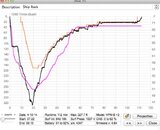We've had an unlikely occurrence at out local mudhole, Golf Ball Reef. The temperatures have warmed from a low of 48° in April to water as warm as 61° in October. In the past month Giant kelp has taken over the reef. In areas that were devoid of kelp in early September there are now stalks twenty to thirty feet tall. The fronds of some of the new kelp host bryozoans, hydroids, slugs and small crustaceans. The reef is composed of small rocks, few larger than a basketball. When the kelp forest was thin we would see several stalks floating their holdfasts a couple feet off the bottom. It is amazing that the kelp has thrived with the warmer water and high surf of the past few months.
We're fortunate to have colder, nutrient-filled water off Palos Verdes that supports a rich invertebrate ecosystem, but there are dives when we wish we had some of that 70°+ water Catalina has experienced this year.





